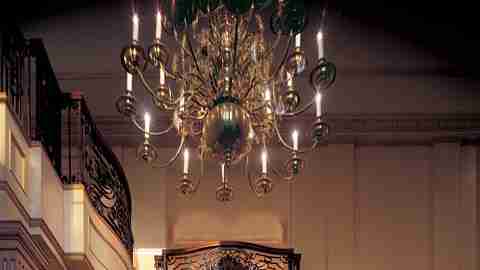The Accent Is French
View Slideshow

How does one make the leap from life in a Manhattan apartment to two acres and 24 rooms and 20,000 square feet of Fine French House?
"Very easily," says Candice Stark, dissolving into a knowing little laugh. At last, she and her husband, Steven, have spread their wings in this New Jersey suburb and are living the life they have long envisioned. Finally, he has a platinum setting for the formal French antiques he collects, as well as Wi-Fi technology and 25 zones of climate control and the cherry-paneled dressing room every man secretly wants. Finally, she has a dining room that can seat 30 on a special night, as well as a more intimate dining room for the family she dotes on, and still there is space for her most private indulgences: a gym and a dressing room where the cashmere is as organized as the Library of Congress. And as for the couple's three children, they hardly know where to turn first, with a third of the house devoted to them. They have their own rooms, but there is also an indoor pool, an indoor basketball court, family rooms and a basement theater with 700 movies downloaded and ready to roll. There's so much fun to be had, nobody says no to an invitation chez Stark.
"I'm happy that they're so happy," says designer Penny Drue Baird, the principal of Dessins, which has its base in New York and one well-shod foot in Paris. Getting this particular commission was rather an honor, Baird says. Steven Stark is the president of Stark Carpet Corporation, which was founded by his father in the 1940s. He and his brother, John, have expanded it to include not only more dazzling carpets but also the fabrics of Old World Weavers and a line of furniture. The Starks know every designer and, more important, how each one works. But Baird had one clear advantage: "Everything French is in my blood," she says.
Steven Stark came of age in another era of interior design, when great rooms were formal rooms. His parents, Nadia and Arthur Stark, names often preceded by the word legendary , had a penchant for French furniture, and this son inherited their taste and eventually much of their collection. The current generation of Starks may be the very picture of a modern, active couple, but in matters of design, they are as traditional as Elsie de Wolfe: French is preferable. And, says Steven Stark, "Baird has lived in France. She shops in France. She has the sources. She has the access." And access is crucial, the way this designer works. "Decorating isn't just a question of what goes with what; it's very much a question of what's available," Baird says. "It's a little like cooking dinner at my apartment in Paris. You go to the market, you see what's available, and you think about what you might do with it."
Construction of the house was well under way when she began her work. It was designed by New York-based architect Boris Baranovich, in whom the Starks recognized "a certain flair." Candice Stark explains: "We didn't want it to feel new. We wanted a sense of grandeur and elegance, but we also wanted it to feel like a home."
The welcome starts in the stone-paved forecourt; the house embraces you with two wings, as if it's about to kiss you on both cheeks. In you sweep, through double mahogany doors, under a great swooping staircase, onto a pale floor of quarter-sawn oak parquetry, and what lies straight ahead? Not a salon filled with flaking, gilded sofas but a cherry-paneled library and a sprawling, resortlike terrace, a little slice of Cap Ferrat on the Hudson. Baird knew just what to do with that library, too, placing a dramatic back-to-back sofa in the center of it. It is highly unusual to walk into a house of this stature and be greeted by so comfortable a room, but the message is clear: This is a modern and livable house.
"This project was really different," Baird says, "because when people want European antiques today, it's usually the more casual styles they want." The Starks, however, were drawn not only to high style but to all the possibilities of fabric. They have a special appreciation for textures and trimmings, and for the drama of layering pattern upon pattern. Baird took all these variables and translated them for today.
No room is more classically formal than the living room, with its 1895 Steinway and its crystal lamps and the Louis XVI games table that Steven Stark grew up playing chess on; yet Baird mellowed its heady atmosphere with crewelwork draperies and an oak armoire.
The dining room is dominated by a spectacular 19th-century chandelier and an 18th-century limestone mantel, yet the wall panels with Chinese scenes encircling the room keep the mood playful. The master suite could have been the dressiest room of all, with its boiserie and Rococo cornice above the headboard and royal palette of gold and blue, but Baird's restrained hand grounded it in this century.
Of course, in this house one is constantly looking down. The vast needlepoint in the living room, a checkerboard of florals and scenes, is based on 17 thcentury Russian fragments that Steven Stark had been waiting for years to transform into a room-size carpet. The dining room is built around a Bessarabian, because, he says, "you don't see them all that often anymore." There's a wool Savonnerie in the master suite and an Aubusson in his dressing room.
And in the basement movie theater, there's a French petit point rug in one of the company's best-known and most intriguing patterns, Leopard Rose , which looks just like it sounds. Even in the dark, it's comforting for a Stark to know there's something beautiful on the floor.